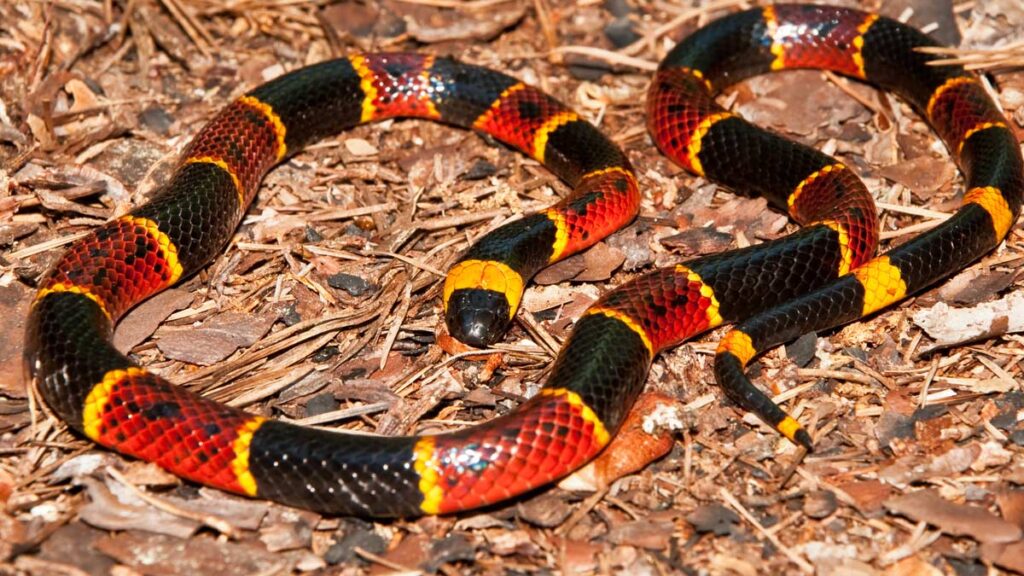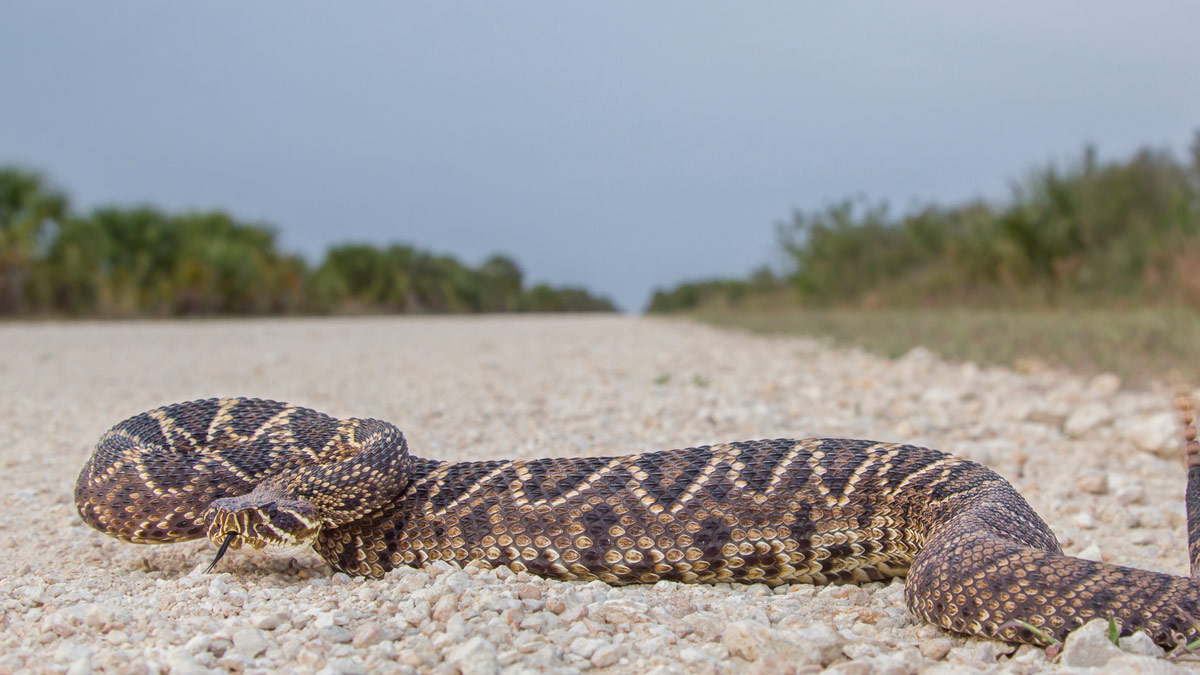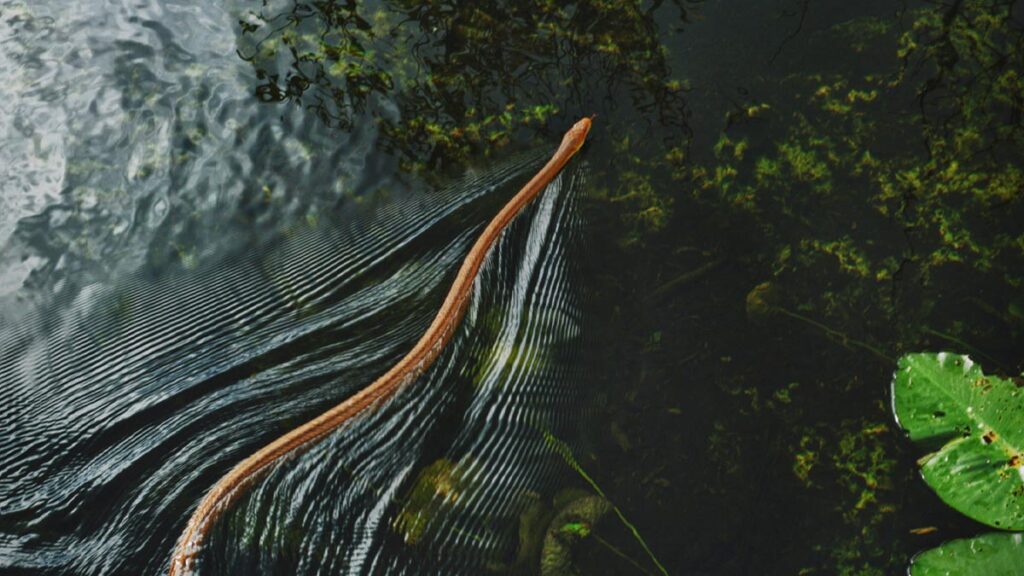
Eastern Diamondback Rattlesnakes in Florida
Understanding the Dangers and Coexisting Safely
Updated on: January 2024

The Eastern diamondback rattlesnake, scientifically known as Crotalus adamanteus, is one of the most formidable and recognizable reptiles inhabiting Florida. This species with intricate diamond-shaped patterns on its back and a characteristic rattle at the tail end, is the largest venomous snake in North America and one of the most potent. While potentially dangerous, it is important to understand their role in the ecosystem and the real dangers they pose. Knowledge and respect can create a peaceful coexistence between humans and these predators.
Find What You Need
Identification and Natural Habitat
The Eastern diamondback rattlesnake’s distinct appearance sets it apart from other snake species found in Florida. Mature snakes can reach lengths of up to 8 feet, making them the largest rattlesnakes in North America. Their most distinguishing feature is their pattern, a series of dark diamond-shaped markings bordered by lighter scales, running down the length of their backs. This pattern, combined with their broad, triangular head and unbroken dorsal stripe, make them relatively easy to distinguish from species like the pygmy rattler or the cottonmouth, both of which also populate Florida.
You would typically encounter them in the state’s dry, upland areas. The pine flatwoods, coastal scrub habitats, and sandy woodlands are ideal environments for these reptiles. They often take refuge in gopher tortoise burrows or under fallen logs, which offer shelter from the elements and predators. However, as urbanization continues to infringe on these natural landscapes, it’s not uncommon for residents to find these snakes in backyards or even on golf courses, especially those areas adjacent to their natural habitats.
The Eastern diamondback’s rattle is a hallmark warning sign. Composed of keratin segments, each rattle is unique to the snake, with a new segment added after each shedding. When vibrated, these segments create the rattlesnake’s distinguishable buzz. While other rattlesnakes, such as the timber rattler, also produce a warning rattle, the Eastern diamondback’s sound is typically louder and more rapid due to its larger size and the structure of its rattle segments. It’s a sound that serves as natural cautionary alert.
Take Away
The Eastern diamondback rattlesnake is an integral part of Florida’s ecological tapestry, deserving respect and understanding. As urbanization intersects with wild habitats, education becomes essential to foster coexistence. By promoting knowledge about this iconic reptile, Floridians can navigate potential encounters safely and appreciate the snake’s vital ecological role.
The Life Cycle and Behavior of the Eastern Diamondback
The dietary preferences of the Eastern diamondback rattlesnake evolve as they grow. Juvenile rattlesnakes, being smaller, tend to prey on smaller animals such as insects, amphibians, and smaller lizards. As they mature, their appetite transitions to larger prey. Adult Eastern diamondbacks have powerful venom and are capable of taking down sizable meals including rabbits, rats, and birds. The ambush predators usually wait patiently for prey to approach, striking with precision and speed. Once bitten, the prey is released and the snake trails it until the venom takes effect, ensuring that the snake does not become a victim of its injured prey.
Regarding reproduction, these snakes mate in the late summer and early fall, but females have the ability to store the sperm, only fertilizing their eggs the following spring. After a gestation period of around six months, females give birth to live young, usually in broods ranging from seven to twenty-one snakes. Unlike many other species, rattlesnakes exhibit some maternal instincts, with the mother staying with her young for a short while after birth, protecting them during their most vulnerable phase.
Seasonally, the behavior of Eastern diamondbacks is largely dictated by Florida’s climate. In the warmer months, they are primarily nocturnal, avoiding the heat of the day. Come winter, their activity decreases significantly, and while they don’t truly hibernate, they do enter a period of decreased activity known as brumation, usually retreating to their burrows. Spring and fall, with their milder temperatures, tend to be the periods of greatest activity, which coincides with their mating season. Human encounters with these snakes are thus more likely during these transitional seasons when the snakes are on the move and actively hunting.
The Impact of Eastern Diamondback on Florida’s Ecosystem and Culture
The Eastern diamondback rattlesnake plays an indispensable role in Florida’s ecological balance. As apex predators, they assist in controlling rodent populations, which, if left unchecked, can be detrimental to agricultural crops and stored grain. By preying on creatures like rats and mice, these snakes indirectly curb the spread of diseases associated with these rodents. In a ripple effect, they also impact the populations of animals that feed on rodents, ensuring a balanced food chain. Furthermore, as prey themselves, they become meals for larger predators, further involving them in the ecosystem.
Considering predators to these snakes, birds of prey such as the red-tailed hawk and the barred owl have been known to snatch up younger, more vulnerable rattlesnakes. On the ground, the bobcat and the coyote might prey on an adult snake if the opportunity arises. Yet, one of the most surprising predators is the king snake, which possesses a natural immunity to the diamondback’s venom, allowing it to consume these venomous reptiles.
The rattlesnake occupies a revered space as part of Florida’s history and native cultures. For indigenous tribes, the snake’s deadly nature was symbolic of power and transformation. Some tribes, like the Seminole, incorporated the rattlesnake motif into their crafts, notably in patchwork designs. Furthermore, the snake’s rattle was often used in ceremonial music. Even in more recent history, the Eastern diamondback’s image has been employed as a symbol of the original 13 colonies, most famously depicted in the “Don’t Tread On Me” flag, emphasizing its significance not just ecologically, but culturally and historically as well.
Dangers and Health Concerns
Understanding the effects of a snake bite from an Eastern diamondback and how to properly treat and manage it is essential in promoting your safety.
Venom and its Effects
The venom of the Eastern diamondback rattlesnake is a complex concoction of enzymes and proteins designed to immobilize and digest prey. When introduced to the human body, its effects can be severe and, in some cases, fatal. Initial symptoms include immediate pain and swelling at the site of the bite, followed by discoloration and potential tissue necrosis. Systemic symptoms can manifest as chills, fever, nausea, abdominal pain, and even organ failure in extreme cases. The venom acts both as a neurotoxin, affecting the nervous system, and a cytotoxin, causing cellular damage, making timely treatment essential.
Treatment and First Aid
If bitten, the primary focus should be to get medical attention immediately. While waiting for help, be sure to keep the affected limb immobilized at heart level and to avoid any tight tourniquets which can exacerbate tissue damage. One of the most effective treatments for a venomous snakebite is the administration of antivenom. Products like CroFab® and Anavip® are designed to counteract the effects of rattlesnake venom, but they’re most effective when administered shortly after the bite. These treatments can be expensive, with costs ranging from $20,000 to $50,000 per vial, and multiple vials might be needed, suggesting the importance of carrying suitable health insurance or being financially prepared.
Medical Expertise
In Florida, medical expertise regarding snakebites is advanced due to the state’s diverse reptilian inhabitants. Several hospitals across the state, including the University of Florida Health Shands Hospital in Gainesville and Miami’s Jackson Memorial Hospital, have specialized units trained to treat venomous snakebites. Additionally, experts like Dr. Ben Abo, a recognized venom response specialist, contribute to research, training, and frontline medical treatment, ensuring that Florida remains at the forefront of snakebite care.
Conservation and Population Dynamics
Over the past several decades, the Eastern diamondback rattlesnake population in Florida has seen a concerning decline. Historically abundant throughout the state, recent studies indicate a significant reduction in their numbers, some estimates suggesting a decrease of up to 30%. Several factors are responsible for this decline including habitat fragmentation due to urban development, road mortality, and over-collection for the pet trade and snakeskin markets.
In response to these trends, conservationists and herpetologists in Florida have undertaken various initiatives to protect and revive the Eastern diamondback population. State organizations, such as the Florida Fish and Wildlife Conservation Commission (FWC), have implemented guidelines to prevent unnecessary killings and restrict collection. The establishment of wildlife preserves and controlled burn practices have also proven beneficial, as they rejuvenate the habitat and enhance prey availability for the rattlesnakes. Several nonprofits, like the Orianne Society, are deeply invested in conserving reptiles and amphibians in the Southeast, running programs that focus on habitat restoration and public education about the diamondback’s important role in the ecosystem.
Climate change further complicates the decreasing Eastern diamondback population as warming temperatures and altered precipitation patterns can influence the rattlesnake’s range, forcing them into areas less suited for their survival. Moreover, climate change can also impact the abundance and availability of prey, leading to food scarcity. Shifts in temperature might also disrupt breeding patterns and hibernation cycles, presenting yet another challenge for the future of this Florida species.
Coexisting Safely with Rattlesnakes
Upon encountering this species, certain precautions and measures can be taken to increase your safety. Understanding their behaviors and how to react is of utmost importance.
Precautions
It is essential for hikers and adventurers to be aware of these reptiles when in Florida’s wilderness. Investing in sturdy, ankle-high hiking boots and thick socks can make a significant difference and such gear acts as a first line of defense against accidental bites when hiking for instance. Snake gaiters, such as those offered by brands like TurtleSkin and Crackshot, provide an additional protective layer, especially in areas with tall grass or dense underbrush. Keeping to well-trodden paths, avoiding reaching blindly into areas where visibility is obstructed, and always giving a rattlesnake the space and respect it deserves if encountered is essential.
Residential Safety
In residential areas, homeowners can take several measures to make their properties less appealing to rattlesnakes. Keeping the lawn mowed and free of debris, storing firewood at least a foot off the ground, and sealing potential entry points to homes and sheds all reduce the likelihood of an unexpected snake encounter. For those living on the fringes of wild areas, constructing a snake-proof fence, though an investment, can greatly increase safety. Such fences, ideally made of solid materials or fine mesh, should be buried several inches underground and stand at least three feet tall.
Non-lethal Deterrents
Non-lethal deterrents including products like Snake-A-Way and Liquid Fence Snake Repellent offer solutions that, when sprinkled or sprayed around properties, claim to deter snakes by disrupting their sensory organs. However, homeowners should be cautious and research each product’s effectiveness and environmental impact before widespread use. Remember, the goal is coexistence, not eradication. The Eastern diamondback rattlesnake, though potentially dangerous, remains an integral part of Florida’s ecosystem.
Legal and Ethical Considerations
In Florida, like in many states, wildlife is considered a public resource, and laws are in place to protect both the animals and the people. Killing or harming this species without a valid reason, such as immediate self-defense, can lead to legal repercussions. Under the Florida Fish and Wildlife Conservation Commission’s regulations, it’s prohibited to intentionally kill, injure, or capture these snakes without the necessary permits. Violations can result in hefty fines and, in cases of repeated or egregious offenses, even jail time.
For residents who find an Eastern diamondback on their property and wish to have it removed, be sure to approach the situation with caution. DIY methods such as the snake-handling tools available online come with significant potential dangers. Brands like Midwest Tongs and Snake Professional offer specialized equipment for safe snake handling, but the risk of being bitten remains without the proper training. Moreover, relocating a rattlesnake without knowledge of appropriate habitats can lead to the snake’s death or ecological imbalances in the release area.
Given these challenges, the best course of action for snake relocation is to engage a licensed professional. Many herpetologists and specialized wildlife removal experts in Florida have undergone training to handle and relocate venomous snakes safely. Enlisting these professionals allows for homeowners to ensure their safety and uphold ethical standards of treatment toward these creatures.

